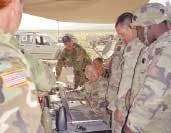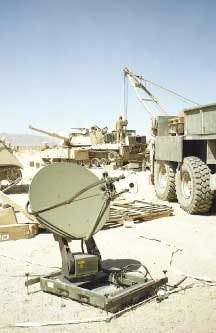By Ben Ames
FORT IRWIN, Calif. — An active Army uses colossal amounts of beans, boots, and bullets as it fights; it is the job of Army logistics staff to keep those supplies in stock.
Last month, that job got a whole lot easier when soldiers at the National Training Center at Fort Irwin, Calif., tested a mobile satellite network called Combat Service Support — Very Small Aperture Terminal (CSS VSAT).
It is an easily moved data network that uses 1.2-meter satellite dishes arranged by the hundreds or even thousands in a star configuration around central hubs, which use 6- to 9-meter dishes.
That builds an instant, global, wide-area network, says George Knizewski, a civilian communications engineer helping the Army's Third Mechanized Infantry Division, based at Fort Stewart, Ga., test the new system.
Soldiers in Fort Irwin, Calif., learn to use the new CSS VSAT network from Chief Warrant Officer 2 Angel Montero (center, seated), a technician for the 3rd Infantry Division, and Bill Flynn (center, standing, in black cap), logistics-assistance representative from the Army Communications-Electronics Command (CECOM).
The parts are interchangeable, so Army units can move outside the continental U.S. (CONUS) and simply plug back into the grid. "You can take a VSAT from CONUS to another part of the world, and it will connect through a different satellite, but link onto the same network," Knizewski says.
That is not merely a small improvement to improve a data network for Army logisticians — this is the first network they have ever used.
"This is for elements of the Army that didn't have a data- communications link before; they had used voice communications and 'sneaker-net,' " says Maj. Michael J. Devine. 'Sneaker-net' refers to exchanging information on floppy disks.
Devine is the acquisition program manager for Defense Wide Transmission Systems in the Program Executive Office for Enterprise Information Systems in Fort Belvoir, Va.
Until now, if a soldier needed new parts for the motor pool, he would enter the order into a local computer, eject the floppy disk, and drive his truck to the closest depot, where he would hand the disk to another soldier, who would plug it into his own computer to fill the order.
"In military parlance, it's called dropping a disk, and it's very painful," Devine says.
"Now they can do it from their own desk, and even check if there's another spare part somewhere closer. Where I used to have to send 10 convoys through 'RPG Alley' between Baghdad and Fallujah (Iraq), now I have to send only one. Sending fewer soldiers on the road is saving lives."
The VSAT system is more powerful than a simple satellite phone. Satellite communications have long been standard battlefield tools, with soldiers using Inmarsat terminals and Iridium phones to share crucial data.
That technology, known as single channel per carrier (SCPC), has a drawback. Like a standard home telephone, it uses a dedicated line that stays silent during all the lapses and gaps in typical human conversation.
This approach wastes a lot of bandwidth because the nature of data is "bursty," running in spurts of voice traffic or video conferencing, Knizewski says.
In contrast, the new VSAT network uses a technology called time-division multiple-access (TDMA). Under that approach, many users can share the bandwidth, filling up the empty spots. Network administrators can assign high-ranked users a priority status so they always get first dibs on available space.
Soldiers ordered parts for M1A1 main battle tanks using this CSS VSAT satellite-communications system set up at the Unit Maintenance Collection Point during a 3rd Infantry Division training exercise.
A typical satellite phone link is 64 kilobits per second, whereas the VSAT system runs at 2 megabits for downloading and 256 kilobits for uploading. That asymmetrical, Internet Protocol-based data flow is a type of intranet similar to NIPRNet, the Pentagon's uNclassified but sensitive IP Router Network, he says.
Until now, crews have used 2.4-meter-diameter dishes in the field to support two-way T-1 data links. By building VSAT asymmetrically, technicians were able to shrink those satellite dishes to half the size.
"It is lighter and more transportable. And the bandwidth savings is tremendous; you get efficiencies of 10:1 or 20:1 compared to SCPC," Knizewski says.
Each VSAT terminal also offers onboard encryption and a wireless local-area network so it can connect to other local computers. It uses an enhanced 802.11b wireless standard called the Combat Service Support — Automated Information System Interface (CAISI), capable of reaching several miles in open terrain.
"The impact is dramatic," Devine says. "Take it from a guy who has spent a lot of time running wires through the woods, over roads, and under bridges. One of the longest links we have in Iraq is 10 miles, to an ammo dump. There's a good reason it's that far away, but it's still a long way to string cable."
In comparison, soldiers can set up a VSAT link in 30 minutes, and the wireless link in 15 minutes.
"We serve combat-support services — moving beans, bullets, fuel, water, repair, maintenance, medical, and administration equipment. Basically all the non-killing elements," Devine says.
Logistics soldiers can now use VSAT as an Internet-collaboration tool, tracking all those items with voice-over-IP telephony, text messaging, and text conferencing.


